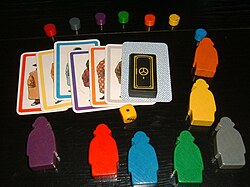Heimlich & Co.
| Heimlich & Co. | |
|---|---|
 equipment |
|
| Game data | |
| author | Wolfgang Kramer |
| graphic |
Matthias Wittig (1984) Dietrich Lange (1986) Oliver Freudenreich (2001) |
| publishing company |
Edition Guinea Fowl (1984), Ravensburger (1986), Amigo (2001), Rio Grande Games , 999 Games , etc. a. |
| Publishing year | 1984, 1986, 2001 |
| Art | Bluff game |
| Teammates | 2 to 7 |
| Duration | 30-40 minutes |
| Age | from 8 years
|
| Awards | |
|
|
Heimlich & Co is a board game with simple rules and a bluff character by Wolfgang Kramer . The game was published in German in 1984 by Edition Perlhuhn , then in 1986 by Ravensburger and in 2001 in a new design by Amigo . The game was also published in other languages (including English, Dutch, Spanish). In addition to the Golden Pöppel 1985 and 1986, the game of the year 1986, it also received the Swiss Games Award 2002 in the family games category.
content
- 7 agent cards
- 7 agent figures
- 7 scoring stones
- 1 safe stone
- 1 dice, game board and instructions
With the new edition of the Amigo publishing house, 26 event cards , so-called top secret cards, were added.
Course of the game
In a village with different houses there are seven secret agents who can be moved by all players by dividing the dice's eyes. At the beginning of the game, each player has secretly drawn an agent without knowing the other players and tries to let him collect as many points as possible in the course of the game. Points are always awarded when any agent hits the vault , who can then be moved to another location again and again. Then everyone is credited with the value of the house they are in. If the agent is in the ruins, however, he receives 3 minus points. The winner is whoever crosses the target first with his scoring marker.
The special attraction of the game lies in the fact that you are not clear about the identity of the players until the game is dissolved, and many agents are empty , i.e. without players. So it is important not to identify yourself by constantly high ratings, otherwise you will be dragged or boycotted by other players , or even end up in ruins.
variants
- In the original game, there is already a variant that, at the end of the game, by placing a tip in the middle of the game, enables all players to win additional points, provided that the individual identities of the agents can be revealed. If the observations are correct, even a player who did not bring his marker to the finish line first can win.
- In the new edition of Amigo-Spiel und Freizeit there are 26 event cards that can be used to influence scoring rounds, as well as other tactical bluff options .
The game is the archetype of the so-called Kramer track , a point track around the actual game board, on which the current score can be marked for everyone to see. This bar has since been used in many other games.
Origin and reception
Heimlich & Co. was developed by Wolfgang Kramer and presented as a prototype for the first time at the Göttingen game designer meeting, before it was published in 1984 in the edition Guinea Fowl by Reinhold Wittig . In this edition, the game was included on the selection list of the Game of the Year 1985 and won first place at the Golden Pöppel in 1985 and 1986. The game was published by Ravensburger in 1986 and in this version was named Game of the Year 1986. In 2002, it was also voted the winner of the Swiss Games Prize .
Radio plays
In 1988 the Karussell-Verlag brought out a radio play series with six episodes. In this series, three children go on a gangster hunt in the fictional city of Nebelburg. The series was apparently inspired by the great success of the Scotland Yard radio plays, which were also derived from the board game of the same name . Heimlich & Co, on the other hand, was aimed at a slightly younger audience and was obviously much less successful. In early 2013, all episodes were re-released as mp3 by Highscore Music .
The following titles were published in the radio play series:
- Episode 1: The mysterious safe
- Episode 2: Dangerous Photos
- Episode 3: The miracle machine
- Episode 4: Excitement in the Mist Castle
- Episode 5: Magic in the Ruin
- Episode 6: The Old Lady's Will
supporting documents
- ^ Edwin Ruschitzka: Göttingen authors' meeting - bridge between inventors and publishers. spielbox 4/94, 1994; Pp. 22-23.
Web links
- How to play Heimlich & Co. at Ravensburger
- Heimlich & Co. at game of the year
- Heimlich & Co at Amigo
- Discussion at spieletest.at
- Heimlich & Co. (Edition Guinea Fowl) in the Luding games database
- Heimlich & Co. (Ravensburger) in the Luding games database
- Heimlich & Co. (Amigo) in the Luding games database
- Heimlich & Co. in the board game database BoardGameGeek (English)
